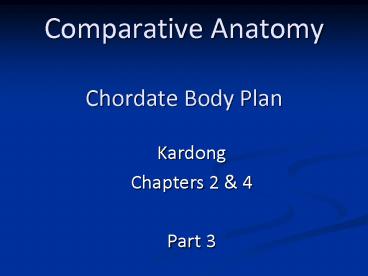Comparative Anatomy Chordate Body Plan - PowerPoint PPT Presentation
1 / 18
Title:
Comparative Anatomy Chordate Body Plan
Description:
Comparative Anatomy Chordate Body Plan Kardong Chapters 2 & 4 Part 3 Pharynx (fair-inks) with slits Pharyngeal arches- associated with slits Anamniotes (lower ... – PowerPoint PPT presentation
Number of Views:638
Avg rating:3.0/5.0
Title: Comparative Anatomy Chordate Body Plan
1
Comparative AnatomyChordate Body Plan
Kardong Chapters 2 4 Part 3
2
Pharynx (fair-inks) with slits
- Figure 3.1. Pharyngeal arches
- lateral view and
- (b) ventral cross section.
- Pharyngeal arches- associated with slits
- Anamniotes (lower vertebrates)- have gill slits
- Amniotes- have slits in embryo but gills never
form - Endodermal pouches- pharyngeal pouch that grows
toward surface of animal give rise to glandular
tissue - Ectodermal groove- pharyngeal groove on outside
that grows toward each pouch
3
Embryonic Features
Figure 3.2. Embryo pharyngeal arches.
Figure 3.3. Embryo development at 1 month.
4
(a)
- In tetrapods, 1st pharyngeal slit becomes
auditory tube and middle ear cavity - Aortic arches housed within pharyngeal arches
(b)
Figure 3.4. Early pharyngeal devel. of shark (a)
early stage (b) later stage .
5
Figure 3.5. Fate of the pharyngeal arches.
- 1st (mandibular) arch- mandibular and maxillary
portions - 2nd (hyoid) arch
- Other arches are numerically named
- Most vertebrates have 6 pairs of arches
6
Figure 3.6. Pharyngeal arches.
- Each pharyngeal arch contains a cartilage,
artery, mesoderm component, and cranial nerve.
7
General Body Plan
- Head
- Trunk
- Tail
Figure 3.7. Sagittal section of craniate embryo.
8
Head
- Head
- Cephalization- development of sense organs
- Protective covering of dermal bone (not
replacement bone) or cartilage
Figure 3.8. Head region (internal view).
9
Trunk
- Somites- muscle masses beside notochord
embryonic structures that give rise to muscle and
bone - Coelom- body cavity between gut and body wall,
lined by peritoneum
Figure 3.10. Gut region.
Figure 3.9. Coelom.
10
Trunk (cont.)
- Other visceral organ cavities
- Heart- pericardium
- Lungs- pleura
- Abdomen- peritoneum
Figure 3.11. Pericardium cavity.
Figure 3.12. Pericardium and pleural cavities.
11
Tail
- From vent/anus to end of the body.
- Somites and notochord
- Innervations
- Dorsal and ventral aorta
- Food storage, defense, locomotion
12
Pituitary Development
Figure 3.13.
- Stomodeal ectodermal plate pushes inward and
forms pocket (Rathkes pouch) that leads to
anterior lobe - This invagination meets the dienchephalons
infundibular process which forms the posterior
lobe
Figure 3.14.
13
Morphological Characteristics of Vertebrates
- Divided into two superclasses Pisces and
Tetrapoda - Demonstrate bilateral symmetry
- Distinguishing features of vertebrates
- Presence of notochord
- Pharynx with slits
- Dorsal tubular nervous system
- Developed vertebrae
- Post anal tail
14
Notochord
- Most primitive endoskeletal structure
- Jawless fish- notochord long and enlarged
- Cartilagenous fish- notochord surrounded by
cartilagenous vertebrae - Bony fish and amphibians- notochord surrounded by
larger vertebrae - Amniotes- notochord almost lost
15
Notochord (cont.)
- In mammals, between successive centrums are disks
- Within disks, the notochord is mostly replaced
with pulpy nucleus
Figure 3.15. Vertebrae.
Figure 3.16. MRI scan of vertebrae.
16
More Vertebrate Features
- Dorsal nervous system
- CNS- brain and spinal cord
- Anamniotes- 10 pairs of cranial nerves
- Amniotes- 12 pairs of cranial nerves
- Vertebral column
- Backbones
- Post anal tail
Figure 3.17. Vertebral column.
17
Anatomical Symmetry and Planes
Figure 3.18. Anatomical terminology.
Figure 3.19. Anatomical terminology.
18
Cranial Nerves
- Olfactory
- Optic
- Oculomotor
- Trochlear
- Trigeminal
- Abducens
- Facial
- Vestibulocochlear
- Glossopharyngeal
- Vagus
- Amniotes (2 more)
- Spinal Accessory
- Hypoglossal
Figure 3.20. Mammalian cranial nerves.































